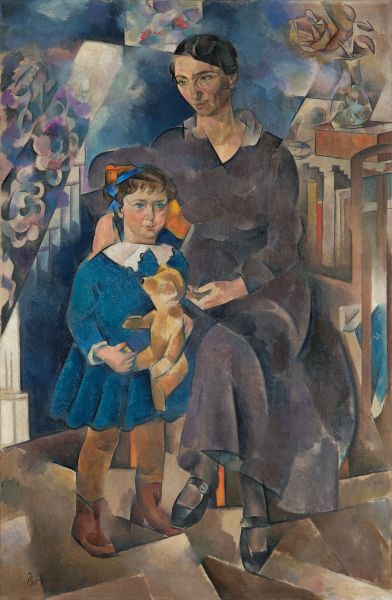|
|
Portrait of Lidia and Olga Rybakova. 1919–1921

Baranoff-Rossiné Vladimir,
Oil on canvas
145,5 х 99,5
State Russian Museum
Пост. в 1986 от О. И. Рыбаковой, Ленинград
Annotation
Lidia Yakovlevna Rybakova (1885–1953) and Olga Iosifovna Rybakova (1915–1998): wife and daughter of the Petrograd lawyer and collector Iosif Izrailevich Rybakov (1880–1938), who commissioned the portrait.
This is a typical work by Vladimir Baranoff-Rossiné, an artist who closely followed the changes taking place in art. Baranoff-Rossiné made a name for himself in Paris as the painter of Smithy (1911) – which Guillaume Apollinaire called the world’s first Futurist picture – as well as Cubist polychrome sculptures and non-objective canvases with the Möbius strip motif. On his return to St Petersburg in 1917, the artist found the Russian art world dominated by two major movements: avant-garde art and neoclassicism. Like Nathan Altman, Vladimir Baranoff-Rossiné reaches a stylistic compromise, a parody of the traditional official portrait, with his unexpected and witty combination of Neoclassical elements – a tendency towards “large form” and a near-sculptural interpretation of the face and figures – and the Cubo-Futurist devices of intersecting colour planes, geometrisation and simplified, ornamental forms. The artist created warm and lyrical images of maternity and childhood, contrasting the drama of life in Russia during the years following the revolution.
Author's Biography
Baranoff-Rossiné Vladimir
Baranoff-Rossiné, Vladimir (Shulim Wolf) Davidovich
1888, Bolshaya Lepatikha, Tauride Province — 1944, France
Painter, graphic artist, sculptor, musician, and theorist of colour music, Vladimir Baranoff-Rossiné studied for one year at the Odessa School of Art, then the Higher School of Art, Imperial Academy of Arts from 1903 to 1907 and for three further yearsat a private studio in Paris. He contributed to exhibitions from 1907 onwards, including Salon d’Automne (Paris, 1913) and Salon des Indépendants (Paris, 1913, 1925–1942). During the early 1910s he worked in Paris before moving to Scandinavia in 1915, then back to Russia two years later. In 1919, he joined IZO Narkompros in Petrograd, and held positions as professor and dean at the Higher Art and Technical Studios in Moscow during the early 1920s. His first optophonic concerts were held at the Vsevolod Meyerhold Theatre and the Bolshoi Theatre in Moscow in1923. Heemigrated to Paris two years later, where he developed the plastic principle based on the Möbius strip. Baranoff-Rossiné died during World War II in a concentration camp.

